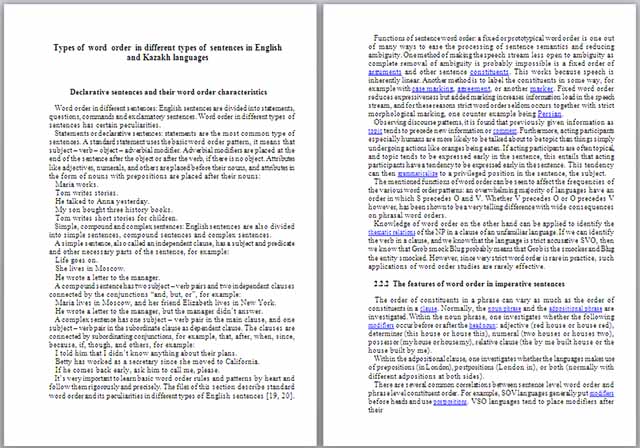| Types of word order in different types of sentences in English and Kazakh languages
|
|
|
Declarative sentences and their word order characteristics
Word order in different sentences: English sentences are divided into statements, questions, commands and exclamatory sentences. Word order in different types of sentences has certain peculiarities. Statements or declarative sentences: statements are the most common type of sentences. A standard statement uses the basic word order pattern, it means that subject – verb – object – adverbial modifier. Adverbial modifiers are placed at the end of the sentence after the object or after the verb, if there is no object. Attributes like adjectives, numerals, and others are placed before their nouns, and attributes in the form of nouns with prepositions are placed after their nouns:
Maria works.
Tom writes stories.
He talked to Anna yesterday.
My son bought three history books.
Tom writes short stories for children.
Simple, compound and complex sentences: English sentences are also divided into simple sentences, compound sentences and complex sentences.
A simple sentence, also called an independent clause, has a subject and predicate and other necessary parts of the sentence, for example:
Life goes on.
She lives in Moscow.
He wrote a letter to the manager.
A compound sentence has two subject – verb pairs and two independent clauses connected by the conjunctions “and, but, or”, for example:
Maria lives in Moscow, and her friend Elizabeth lives in New York.
He wrote a letter to the manager, but the manager didn’t answer.
A complex sentence has one subject – verb pair in the main clause, and one subject – verb pair in the subordinate clause as dependent clause. The clauses are connected by subordinating conjunctions, for example, that, after, when, since, because, if, though, and others, for example:
I told him that I didn’t know anything about their plans.
Betty has worked as a secretary since she moved to California.
If he comes back early, ask him to call me, please.
It’s very important to learn basic word order rules and patterns by heart and follow them rigorously and precisely. The files of this section describe standard word order and its peculiarities in different types of English sentences [19, 20].
Functions of sentence word order: a fixed or prototypical word order is one out of many ways to ease the processing of sentence semantics and reducing ambiguity. One method of making the speech stream less open to ambiguity as complete removal of ambiguity is probably impossible is a fixed order of arguments and other sentence constituents. This works because speech is inherently linear. Another method is to label the constituents in some way, for example with case marking, agreement, or another marker. Fixed word order reduces expressiveness but added marking increases information load in the speech stream, and for these reasons strict word order seldom occurs together with strict morphological marking, one counter example being Persian.
Observing discourse patterns, it is found that previously given information as topic tends to precede new information or comment. Furthermore, acting participants especially humans are more likely to be talked about to be topic than things simply undergoing actions like oranges being eaten. If acting participants are often topical, and topic tends to be expressed early in the sentence, this entails that acting participants have a tendency to be expressed early in the sentence. This tendency can then grammaticalize to a privileged position in the sentence, the subject.
The mentioned functions of word order can be seen to affect the frequencies of the various word order patterns: an overwhelming majority of languages have an order in which S precedes O and V. Whether V precedes O or O precedes V however, has been shown to be a very telling difference with wide consequences on phrasal word orders.
Knowledge of word order on the other hand can be applied to identify the thematic relations of the NP in a clause of an unfamiliar language. If we can identify the verb in a clause, and we know that the language is strict accusative SVO, then we know that Grob smock Blug probably means that Grob is the smocker and Blug the entity smocked. However, since very strict word order is rare in practice, such applications of word order studies are rarely effective.
The features of word order in imperative sentences
The order of constituents in a phrase can vary as much as the order of constituents in a clause. Normally, the noun phrase and the adpositional phrase are investigated. Within the noun phrase, one investigates whether the following modifiers occur before or after the head noun: adjective (red house or house red), determiner (this house or house this), numeral (two houses or houses two), possessor (my house or house my), relative clause (the by me built house or the house built by me).
Within the adpositional clause, one investigates whether the languages makes use of prepositions (in London), postpositions (London in), or both (normally with different adpositions at both sides).
There are several common correlations between sentence level word order and phrase level constituent order. For example, SOV languages generally put modifiers before heads and use postpositions. VSO languages tend to place modifiers after their
heads, and use prepositions. For SVO languages, either order is common [20, 41].
For example, French SVO uses prepositions, and places adjectives after. However, a small class of adjectives generally goes before their heads. On the other hand, in English, also SVO adjectives almost always go before nouns (a big car), and adverbs can go either way, but initially is more common as greatly improved. English has a very small number of adjectives that go after their heads, such as “extraordinaire”, which kept its position when it was borrowed from French.
Free word order: some languages do not have a fixed word order. In these languages there is often a significant amount of morphological marking to disambiguate the roles of the arguments; however there are also languages in which word order is fixed even though the degree of marking would enable free word order, and languages with free word order, such as some varieties of Datooga, which have free word order combined with a lack of morphological distinction between arguments. Typologically there is a trend that highly animate actors are more likely to be topical than low animate undergoers, this trend would come through even in free word order languages giving a statistical bias for SO order or OS in the case of ergative systems, however ergative systems do not usually extend to the highest levels of animacy, usually giving way to some form of nominative system at least in the pronominal system. Most languages with a high degree of morphological marking have rather flexible word orders such as Latin, Hungarian, Russian in intransitive clauses, and Finnish. In some of those, a canonical order can still be identified, but in others this is not possible [21, 49].
In many languages, changes in word order occur due to topicalization or in questions. However, most languages are generally assumed to have a basic word order, called the unmarked word order; other, marked word orders can then be used to emphasize a sentence element, to indicate modality such as an interrogative modality, or for other purposes.
For example, English is SVO, as in “I do not know this”, but OSV is also possible: “This I do not know”. This process is called topic fronting or topicalization and is common. In English, OSV is a marked word order because it emphasises the object, and is often accompanied by a change in intonation.
An example of OSV being used for emphasis:
I cannot see Alice.
What about Bill?
Bill I can see.
Non standard word orders are also found in poetry in English, as well as in many other languages.
In meteorology, an inversion is a deviation from the normal change of an atmospheric property with altitude. It almost always refers to a temperature inversion, it means an increase in temperature with height, or to the layer or inversion layer within which such an increase occurs [22, 62].
An inversion can lead to pollution such as smog being trapped close to the ground, with possible adverse effects on health. An inversion can also suppress convection by acting as a “cap”. If this cap is broken for any of several reasons, convection of any moisture present can then erupt into violent thunderstorms. Temperature inversion can notoriously result in freezing rain in cold climates.
Normal atmospheric conditions: usually, within the lower atmosphere, the troposphere the air near the surface of the Earth is warmer than the air above it, largely because the atmosphere is heated from below as solar radiation warms the Earth’s surface, which in turn then warms the layer of the atmosphere directly above it, for example by thermals as convective heat transfer.
How and why inversions occur: under certain conditions, the normal vertical temperature gradient is inverted such that the air is colder near the surface of the Earth. This can occur when, for example, a warmer, less dense air mass moves over a cooler, denser air mass. This type of inversion occurs in the vicinity of warm fronts, and also in areas of oceanic upwelling such as along the California coast. With sufficient humidity in the cooler layer, fog is typically present below the inversion cap. An inversion is also produced whenever radiation from the surface of the earth exceeds the amount of radiation received from the sun, which commonly occurs at night, or during the winter when the angle of the sun is very low in the sky. This effect is virtually confined to land regions as the ocean retains heat far longer. In the polar regions during winter, inversions are nearly always present over land.
A warmer air mass moving over a cooler one can “shut off” any convection which may be present in the cooler air mass. This is known as a capping inversion. However, if this cap is broken, either by extreme convection overcoming the cap, or by the lifting effect of a front or a mountain range, the sudden release of bottled up convective energy like the bursting of a balloon can result in severe thunderstorms. Such capping inversions typically precede the development of tornadoes in the midwestern United States. In this instance, the “cooler” layer is actually quite warm, but is still denser and usually cooler than the lower part of the inversion layer capping it [23, 94].
Subsidence inversion: an inversion can develop aloft as a result of air gradually sinking over a wide area and being warmed by adiabatic compression, usually associated with subtropical high pressure areas. A stable marine layer may then develop over the ocean as a result. As this layer moves over progressively warmer waters, however, turbulence within the marine layer can gradually lift the inversion layer to higher altitudes, and eventually, even pierce it, producing thunderstorms, and under the right circumstances, leading to tropical cyclones. The accumulated smog and dust under the inversion quickly taints the sky reddish, easily seen on sunny days. Consequences of a thermal inversion: with the ceasing of convection, which is normally present in the atmosphere, a number of phenomena are associated with a temperature inversion. The air becomes stiller, hence the air becomes murky because dust and pollutants are no longer lifted from the surface.
This can become a problem in cities where many pollutants exist. Inversion effects occur frequently in big cities such as Mumbai, India; Los Angeles, California; Mexico City; Sao Paulo, Brazil; Santiago, Chile; and Tehran, Iran, but also in smaller cities like Oslo, Norway, Salt Lake City, Utah, and Boise, Idaho, which are closely surrounded by hills and mountains that together with the inversion effect bottle caps the air in the city. During a severe inversion, trapped air pollutants form a brownish haze that can cause respiratory problems. The Great Smog, one of the most serious examples of such an inversion, occurred in London in 1952 and was blamed for thousands of deaths [24, 62].
Sometimes the inversion layer is higher so that the cumulus clouds can condense but then they spread out under the inversion layer. This cuts out sunlight to the ground and prevents new thermals from forming. A period of cloudiness is followed by sunny weather as the clouds disperse. This cycle can occur more than once in a day.
The index of refraction of air decreases as the air temperature increases, a side effect of hotter air being less dense. Normally this results in distant objects being shortened vertically, an effect that is easy to see at sunset where the sun is squished into an oval. In an inversion the normal pattern is reversed, and distant objects are instead stretched out or appear to be above the horizon. This leads to the interesting optical effects of Fata Morgana or mirage [25, 75].
Similarly, very high frequency radio waves being part of the electromagnetic spectrum, like light can be refracted by such inversions. This is why it is possible to sometimes hear FM radio or TV broadcasts from otherwise impossible distances as far as a few hundred miles distant on foggy nights. The signal, still powerful enough to be received even at hundreds or rarely, thousands, of miles, would normally be refracted up and away from the ground based antenna, is instead refracted down towards the earth by the temperature inversion boundary layer. This phenomenon is called tropospheric ducting. It is also referred to as skip by small radio operators and Ham operators. Along coast lines during Autumn and Spring many FM radio stations are plagued by severe signal degradation causing them to sound like scrambled eggs.
Inversions can magnify the so called green flash: a phenomenon occurring at sunrise/sunset, usually visible for a few seconds, in which the sun’s green light is isolated due to dispersion the shorter wavelength is refracted most, so it is the first/last light from the upper rim of the solar disc to be seen.
In addition, when an inversion layer is present, for example early in the morning when ground level air temperatures are cool, and high level air temperatures are warmer, if a sound or explosion occurs at ground level, the sound wave can get totally reflected from the warmer upper layer in which the sound travel faster, it means that the air has lower acoustic refractive index, so the sound can undergo total internal reflection and return back to ground level; the sound is therefore heard much further than normal. The shockwave from an explosion can be reflected by an inversion layer in much the same way as it bounces off the ground in an air burst and can cause additional damage as a result. This phenomenon killed three people in nuclear test [26, 73].
In an inversion, vertical motion in the atmosphere is suppressed because the atmosphere is stable. Hence vertical heat transport by eddies is suppressed; this reduced downwards heat transport leads to further cooling of the lower surface. This can lead to an effective decoupling of the atmosphere from the surface in extreme conditions.
The syntactical peculiarities of word order in interrogative sentences
The notion of sentence has not so far received a satisfactory definition, which would enable us by applying it in every particular case to find out whether a certain linguistic unit was a sentence or not.
Thus, for example, the question remains undecided whether such shop notices as Book Shop and such book titles as English are sentences or not. In favour of the view that they are sentences the following consideration can be brought forward. The notice Book Shop and the title English Grammar mean “this is a book shop”, “this is an English grammar”; the phrase is interpreted as the predicative of a sentence whose subject and link verb have been omitted, that is, it is apprehended as a unit of communication. According to the other possible view, such notices as Book Shop and such titles as English Grammar are not units of communication at all, but units of nomination, merely appended to the object they denote. Since there is as yet no definition of a sentence which would enable us to decide this question, it depends on everyone’s subjective view which alternative he prefers. We will prefer the view that such notices and book titles are not sentences but rather nomination units.
We also mention here a special case. Some novels have titles formulated as sentences, for example, “The Stars Look Down”, by A.G. Cronin, or “They Came to a City”, by J.B. Priestley. These are certainly sentences, but they are used as nomination units, for instance, have you read the stars look down? Do you like they came to a city?
With the rise of modern ideas of paradigmatic syntax yet another problem concerning definition of sentence has to be considered [27, 64].
In paradigmatic syntax, such units as he has arrived, he has not arrived, has he arrived, he will arrive, he will not arrive, will he arrive, and others are treated as different forms of the same sentence, just as arrives, has arrived, will arrive etc., are different forms of the same verb. We may call this view of the sentence the paradigmatic view.
Now from the point of view of communication, he has arrived and he has not arrived are different sentences since they convey different information indeed, the meaning of the one flatly contradicts that of the other.
The problem of classification of sentences is a highly complicated one, and we will first consider the question of the principles of classification, and of the notions on which it can be based.
Let us begin by comparing a few sentences differing from each other in some respect. Take, for example, the following two sentences:
1) But why did you leave England? (G.T.Galsworthy)
2) There is to day more people writing extremely well, in all departments of life, than ever before; what we have to do is to sharpen our judgement and pick these out from the still larger number who write extremely badly (G.S. Crump) [28, 53].
Everyone will see that the two sentences are basically different. This is true, but very general and not grammatically exact. In order to arrive at a strictly grammatical statement of the difference or differences between them we must apply more exact
methods of observation and analysis.
Let us, then, proceed to a careful observation of the features which constitute the difference between the two sentences.
The first sentence expresses a question that is the speaker expects an answer which will supply the information he wants. The second sentence expresses a statement, that is, the author or speaker states his opinion on a certain subject. He does not ask about anything, or expect anybody to supply him any information. This difference is expressed in writing by the first sentence having a question mark at the end, while the second sentence has a full stop [29, 54].
The first sentence is addressed to a certain hearer or a few hearers present, and is meant to provoke the hearer’s reaction or answer. The second sentence is not addressed to any particular person or persons and the author does not know how anybody will react to it.
The two sentences differ greatly in length: the first consists of only 6 words, while the second has 39.
The first sentence has no punctuation marks within it, while the second has two commas and a semicolon.
The first sentence has only one finite verb (did, leave), while the second has three (are, have, write).
These would seem to be some essential points of difference. We have riot yet found out which of them are really relevant from a grammatical viewpoint. We have not included in the above list those which are quite obviously irrelevant from that viewpoint; for example, the first sentence contains a proper name England, while the second does not contain any, or, the second sentence contains a possessive pronoun our while the first does not, and others.
Let us now consider each of the five points of difference and see which of them are relevant from a purely grammatical point of view, for a classification of sentences.
Point states a difference in the types of thought expressed in the two sentences. Without going into details of logical analysis, we can merely say that a question as in the first sentence, and a proposition as in the second are different types of thought, in the logical acceptation of that term. The problem now is, whether this difference is or is not of any importance from the grammatical viewpoint. In Modern English sentences expressing questions we will call them, as is usually done, interrogative sentences have some characteristic grammatical features. These features are, in the first place, a specific word order in most cases (predicate – subject), as against the order subject predicate in sentences expressing, propositions (declarative sentences).
Thus word order may, with some reservations, be considered as a feature distinguishing this particular type of sentence from others. Another grammatical feature characterizing interrogative sentences again, with some reservations is the structure of the predicate verb, namely its analytical form “do and infinitive” in our first sentence, did, leave, not left, where in a declarative sentence there would be the simple form without do. However, this feature is not restricted to interrogative sentences: as is well known, it also characterizes negative sentences. Anyhow, we can always with some reservations assume that word order and the form “do and infinitive” are grammatical features characterizing interrogative sentences, and in so far the first item of our list appears to be grammatically relevant. We will, accordingly, accept the types interrogative sentence and declarative sentence as grammatical types of sentences [30, 76].
Point two, treating of a difference between a sentence addressed to a definite hearer or reader and a sentence free from such limitation, appears not to be grammatical, important as it may be from other points of view. Accordingly, we will not include this distinction among grammatical features of sentences.
Point three, showing a difference in the length of the sentences, namely in the number of words making up each of them, does not in itself constitute a grammatical feature, though it may be more remotely connected with grammatical distinctions.
Point four bears a close relation to grammatical peculiarities; more especially, a semicolon would be hardly possible in certain types of sentences so called simple sentences. But punctuation marks within a sentence are not in themselves grammatical features: they are rather a consequence of grammatical features whose essence is to be looked for elsewhere.
Point five, on the contrary, is very important from a grammatical viewpoint. Indeed the number of finite verbs in a sentence is one of its main grammatical features. In this particular instance it should be noted that each of the three finite verbs has its own noun or pronoun belonging to it and expressing the doer of the action denoted by the verb: are has the noun people, have the pronoun we, and write the pronoun who. These are sure signs of the sentence being composite, not simple. Thus we will adopt the distinction between simple and composite sentences as a distinction between two grammatical types.


 Получите свидетельство
Получите свидетельство Вход
Вход












 Материал по английскому языку на тему "Types of word in different types of sentences in Kazakh and English languages" (30.72 КB)
Материал по английскому языку на тему "Types of word in different types of sentences in Kazakh and English languages" (30.72 КB)
 0
0 862
862 58
58 Нравится
0
Нравится
0


